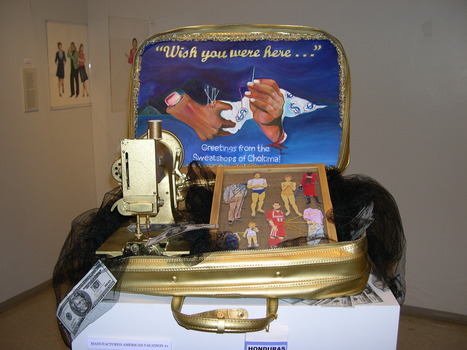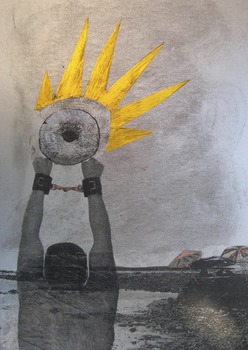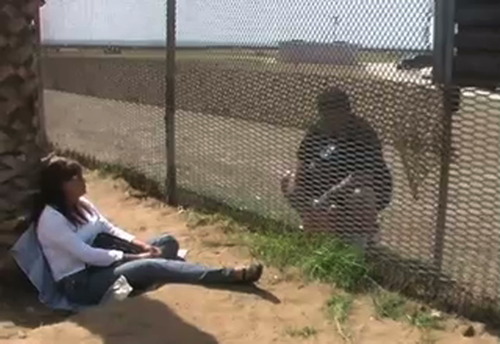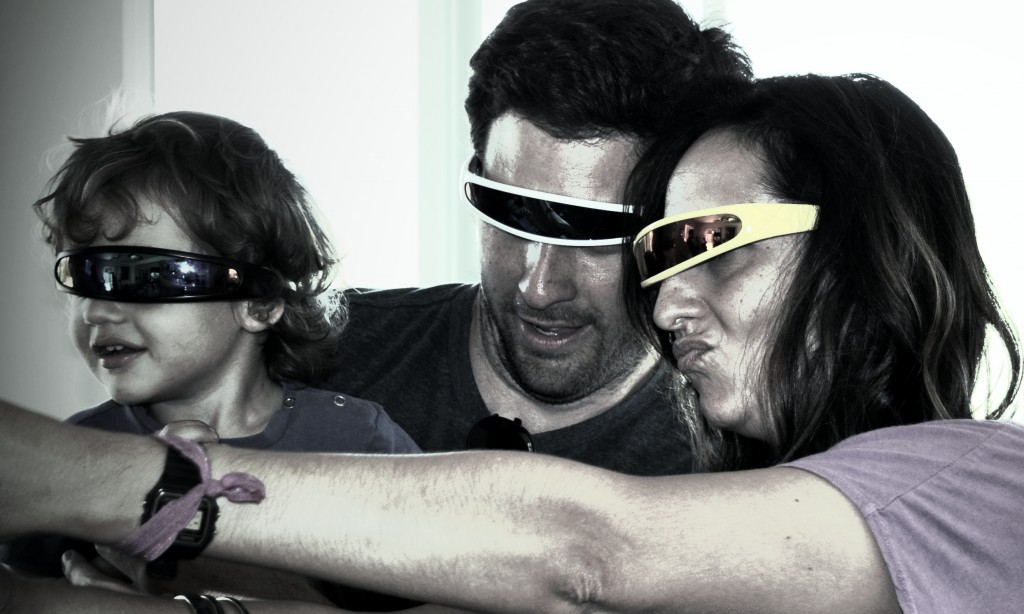
The 4th Annual Los Angeles Anarchist Book Festival took place this year at Barnsdall Park (September 8, 2012). For the last 3 years I wanted to attend, but there had been an element of disorganization in the form of no advance publicity or firm location, even poor communication flow which impeded someone like me (an advance planner) from attending. After all, LA is a weekly buffet of important events.

I don’t know the anarchist credo, but ambitious scheduling and event planning do not seem to be a part of it–it is more an organic social-mutualism when a gathering occurs. There does not seem to be a drive for amassing or controlling ‘things’, instead there is simple living, healthy eating, love of books, knowledge sharing and a great deal of do-it-yourself-ism.

In 1927, Aline Barnsdall donated Barnsdall Park and her Frank Lloyd Wright designed home (The Hollyhock House), to the City of Los Angeles. The intention was to maintain an active and long-lasting arts center for the community. It was a beautiful setting for the Anarchist Book Fair, which spilled out of its Metropolitan Gallery doors into the park with tables of information, books, zines, food, educational selections, unique political history and autobiographical books, health related appeals, social justice causes, musicians, slogan patches and buttons, handmade jewelry and art. Everything extremely affordable, if not free.
According to the day’s schedule handed to me upon arriving, there was an early morning community set-up of the space, indigenous dancers, lunch, and a preview performance of “The Ballad of Ricardo Flores Magon: the unearthing of radical LA historyâ€. There was a children’s play area in the park, as well as art and craft projects.

Shopping does not interest me. I passed up all the book tables, went straight to the vegan tamale line and to get a big drink of cold water. I think that’s when I lost my friend. Its been very hot in Los Angeles for a few weeks now. We are so spoiled with the weather, that any day not being 78 degrees, seems intolerable. After eating I entered the air conditioned gallery and took a stroll around the ample space. I imagined when this was Aline Barnsdall’s home and it amused me to think that no anarchist would ever want to live in such grandeur. The building has had such an interesting history. I also wondered if the McCarthyists had ever met there to plot against Hollywood. This sort of dichotomy is very intriguing to me.

Looking at the schedule of speakers and presentations, I spotted that the rooms in the gallery had been baptized into names like Emma Goldman Room, Ricardo Flores Magon Room, Buenaventura Durruti Room, Enrico Malatesta Room, Lucy Parsons Room, Voltairine de Cleyre Room and the Makhail Bakunin Room. These rooms hosted such topics as “Class War California-style: Riots, Occupations and General Strikes,†“Imperiled Life: Revolution Against Climate Catastrophe,†“Building Autonomous Resistance through Mutual Aid,†“Political Prisoners in North America,†“The Chilean Student Movement,†“Building Power Movements,†“Police Infiltration, Surveillance and Spying,†“Gender Strike,†“Bike Blenders,†“Palestine Solidarity,†“Anaheim Uprising & Cop Watch,†“Igniting the Revolution within a Sex-Positive Approach to Healing,†“Anarchist Parenting,†“Liberation Healing,†“ Now and Then, the Challenges in Anarchism,†and other impromptu topics not listed.
I spied my lost friend in the gallery, where he dwelled the rest of the afternoon in the cool sanctuary. Later, he even took a turn behind one of the book tables, chatting up the books and making sales. I liked the informality.

After being taunted on Facebook with a barrage of announcements about an exhibit called “Look at These Fucking Artists,†I went from word/concept insulted to realizing that this was the art portion of the Anarchist Book Fair. The title took me aback, and in truth I had to warm up to it. I suppose all new art hits one like a slap on the face, or at least it does to me–as it should be.
There was no physical art on the walls at the Anarchist Book Fair, “Look at These Fucking Artists,†were a series of engaging art discussions. I missed the art talks on “Art Labor,†“Mural Moratorium,†and “Text & Actionâ€. As I was standing in the gallery, a young woman came up to me and asked me to join the next art talk on “Beyond LA Xican@isms,†on the balcony. Hmm–a modern version of “Chicano†with a gender inclusive spelling–I’m there! Each discussion of 12 to 15 people started with everyone introducing themselves and the moderator asking a question to the panel about art and anarchism.

In Xican@isms, Fabian Debora, a visual artist who specializes in gang intervention activism and works at Otis College of Art & Design sensitizing students to political correctness in their art work, said that the art world was more political and complicated than being in a gang. That really stuck with me as well as made me smile.
While others attended art discussions on “Institution of Social Practice†and “Propagandaâ€, I attended “LA Zapatismoâ€. Presenter Dr. Roberto Flores, had organized a group of community members in the late 90s for a trip to Chiapas called “Encuentro†(Encounter). The Encuentro was a sharing of ideas with the members of EZLN and LA artists. In the end, art work was created and based on the concepts learned and shared at the Encuentro. After, Dr. Flores established a non-profit meeting/community space in El Sereno and focused the rest of his discussion on LA Zapatismo as it relates to the challenges of being a viable voice in the El Sereno community without being thought of as ‘problematic‘ to the local politicians, by integrating into the community through majority issue support and by being an “under the radar’ physical barrier to community changes/divisions being planned by outsiders.
Next I missed “Pussy Riot†and “Militant Knowledge†to attend “ Narcosâ€. Jen Hofer, demonstrated a portable radio studio she and her colleague use to provide translation services at community meetings where there are Spanish and English monolingual attendees. Her group has provided this service throughout Mexico and especially on the US and Mexico borders, because they feel communication is crucial to these national communities. Artist Raul Baltazar was there to speak of his work with the art movement in the United States that is creating criticism on Narcotraficantes. The Anarchist Book Fair being so organic, soon Raul passed the presentation to me and I became part of this panel too. I spoke of my work starting with the art campaign in support the disappeared women of Juarez 11 years ago. Something I (and Raul) had discussed was the Youtube films that cartel’s upload, in which they are torturing and killing innocents and other drug cartel members with numbing graphic violence. At the same time one must note that these films are an artistic process, with their editing, sound selection and graphic titles choices. Raul continues to question if he should be sensitive to the victims by censoring his art, or if he should be brutally honest in his cartel art, even if it (yet again) wounds the victims.
At the end of the day, I attended “MMOOCCAAâ€, a critique on Eli Broad’s personal hands-on recreation of the art scene in Los Angeles. By appointing key museum personnel who work against the mission of a Museum–i.e. to educate the community about art, he has declared war on the LA art community. Broad and his operatives want to reinvent the museum system into a money making enterprise by curating rave-like art events and featuring east coast artists. This money/power-fueled philanthropy has been interpreted as a hostile belittling of art created in California and the west coast. There were gallery people from LACE and the Hammer Museum in this talk. Interesting that the subject of government supported art should be desired by some of the attendees in this group, as a salvation from well meaning philanthropists. The idea of government control of art as a resolution is contrary to anarchism. Just goes to show that all opinions were valid at the Book Fair.
Next year’s Anarchist Book Fair promises to be even better. The only thing I would change is to make sure to bring my own sack lunch. It was a long, engaging day coupled with humid weather on that balcony—-it would have been good to have a little extra fuel for sustenance.

 Saturday, January 18, 2020
Saturday, January 18, 2020









































 After V-Day the pink squares were used as part of various Juarez Femicide workshops led by Rigo Maldonado and Victoria Delgadillo in 2004 and after. Materials and images of the women of Juarez (collected by Rigo and Victoria) were provided to participants to create protest art. Art is an excellent way to discuss and strategize for difficult social issues.
After V-Day the pink squares were used as part of various Juarez Femicide workshops led by Rigo Maldonado and Victoria Delgadillo in 2004 and after. Materials and images of the women of Juarez (collected by Rigo and Victoria) were provided to participants to create protest art. Art is an excellent way to discuss and strategize for difficult social issues.


































 pires my art, are those around me. If you look at enough of my work, you will start to realize that many of the models I use are people that I know, mostly friends. I suppose all artists draw from their surroundings.
pires my art, are those around me. If you look at enough of my work, you will start to realize that many of the models I use are people that I know, mostly friends. I suppose all artists draw from their surroundings.





![Drummer du jour [heart], Maria Azteca [crown], Jeninche [green circle], James Brownie [star]](https://victoriadelgadillo.com/blog/wp-content/uploads/2012/10/5cdbbe8e-aab8-4038-9d20-e5db1bab6618_zps9a42c7b5-300x226.jpg)































